Aaron D. Ames
Reduced-Order Model Guided Contact-Implicit Model Predictive Control for Humanoid Locomotion
Feb 21, 2025Abstract:Humanoid robots have great potential for real-world applications due to their ability to operate in environments built for humans, but their deployment is hindered by the challenge of controlling their underlying high-dimensional nonlinear hybrid dynamics. While reduced-order models like the Hybrid Linear Inverted Pendulum (HLIP) are simple and computationally efficient, they lose whole-body expressiveness. Meanwhile, recent advances in Contact-Implicit Model Predictive Control (CI-MPC) enable robots to plan through multiple hybrid contact modes, but remain vulnerable to local minima and require significant tuning. We propose a control framework that combines the strengths of HLIP and CI-MPC. The reduced-order model generates a nominal gait, while CI-MPC manages the whole-body dynamics and modifies the contact schedule as needed. We demonstrate the effectiveness of this approach in simulation with a novel 24 degree-of-freedom humanoid robot: Achilles. Our proposed framework achieves rough terrain walking, disturbance recovery, robustness under model and state uncertainty, and allows the robot to interact with obstacles in the environment, all while running online in real-time at 50 Hz.
Learning for Layered Safety-Critical Control with Predictive Control Barrier Functions
Dec 05, 2024Abstract:Safety filters leveraging control barrier functions (CBFs) are highly effective for enforcing safe behavior on complex systems. It is often easier to synthesize CBFs for a Reduced order Model (RoM), and track the resulting safe behavior on the Full order Model (FoM) -- yet gaps between the RoM and FoM can result in safety violations. This paper introduces \emph{predictive CBFs} to address this gap by leveraging rollouts of the FoM to define a predictive robustness term added to the RoM CBF condition. Theoretically, we prove that this guarantees safety in a layered control implementation. Practically, we learn the predictive robustness term through massive parallel simulation with domain randomization. We demonstrate in simulation that this yields safe FoM behavior with minimal conservatism, and experimentally realize predictive CBFs on a 3D hopping robot.
Zero-order Control Barrier Functions for Sampled-Data Systems with State and Input Dependent Safety Constraints
Nov 26, 2024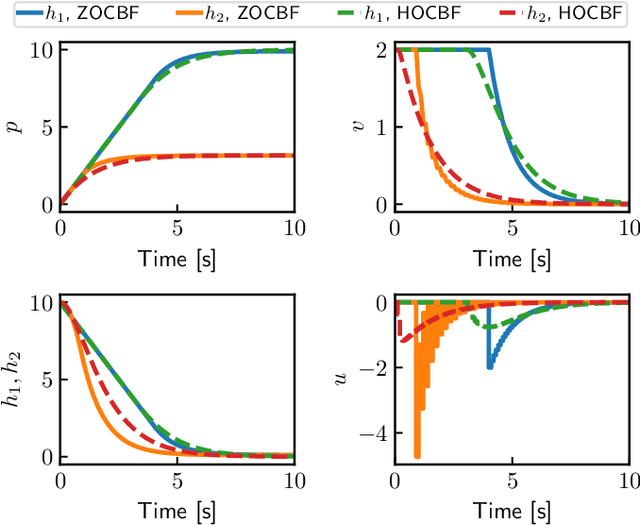
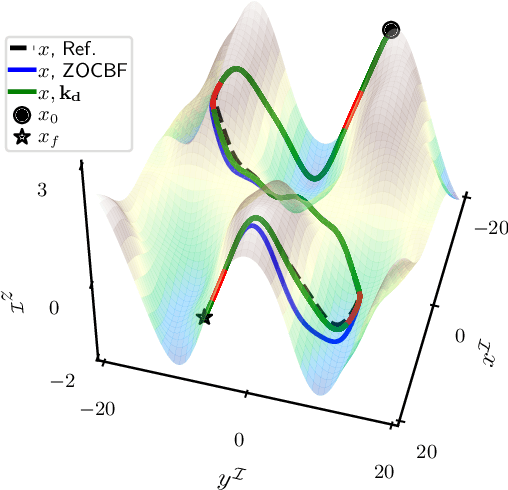
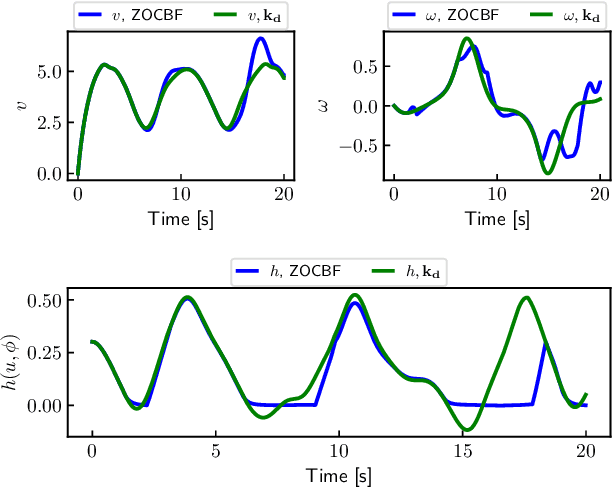
Abstract:We propose a novel zero-order control barrier function (ZOCBF) for sampled-data systems to ensure system safety. Our formulation generalizes conventional control barrier functions and straightforwardly handles safety constraints with high-relative degrees or those that explicitly depend on both system states and inputs. The proposed ZOCBF condition does not require any differentiation operation. Instead, it involves computing the difference of the ZOCBF values at two consecutive sampling instants. We propose three numerical approaches to enforce the ZOCBF condition, tailored to different problem settings and available computational resources. We demonstrate the effectiveness of our approach through a collision avoidance example and a rollover prevention example on uneven terrains.
Safety-Critical Controller Synthesis with Reduced-Order Models
Nov 25, 2024Abstract:Reduced-order models (ROMs) provide lower dimensional representations of complex systems, capturing their salient features while simplifying control design. Building on previous work, this paper presents an overarching framework for the integration of ROMs and control barrier functions, enabling the use of simplified models to construct safety-critical controllers while providing safety guarantees for complex full-order models. To achieve this, we formalize the connection between full and ROMs by defining projection mappings that relate the states and inputs of these models and leverage simulation functions to establish conditions under which safety guarantees may be transferred from a ROM to its corresponding full-order model. The efficacy of our framework is illustrated through simulation results on a drone and hardware demonstrations on ARCHER, a 3D hopping robot.
Dynamic Tube MPC: Learning Tube Dynamics with Massively Parallel Simulation for Robust Safety in Practice
Nov 22, 2024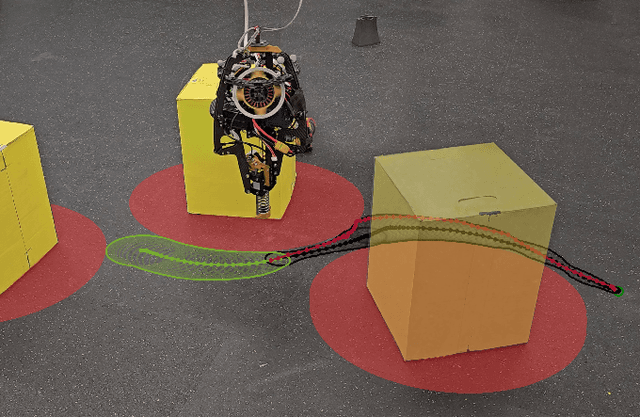

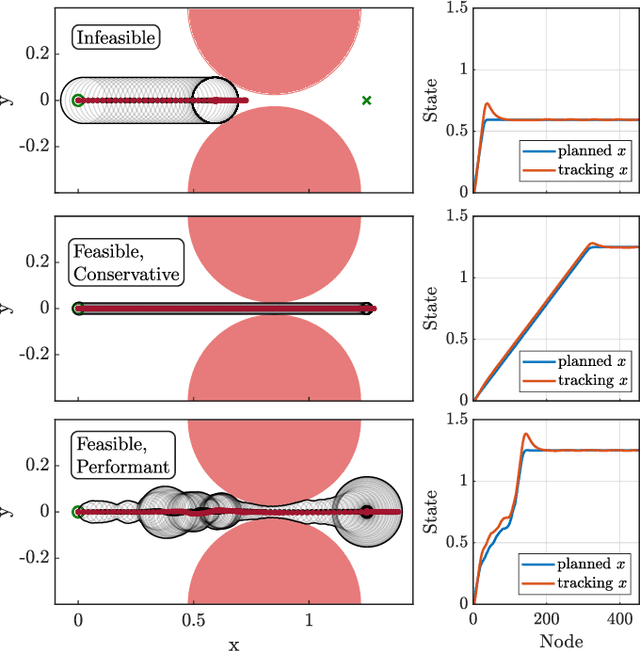
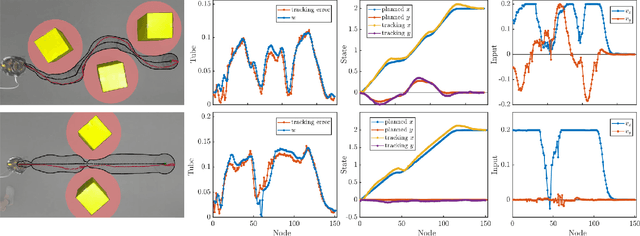
Abstract:Safe navigation of cluttered environments is a critical challenge in robotics. It is typically approached by separating the planning and tracking problems, with planning executed on a reduced order model to generate reference trajectories, and control techniques used to track these trajectories on the full order dynamics. Inevitable tracking error necessitates robustification of the nominal plan to ensure safety; in many cases, this is accomplished via worst-case bounding, which ignores the fact that some trajectories of the planning model may be easier to track than others. In this work, we present a novel method leveraging massively parallel simulation to learn a dynamic tube representation, which characterizes tracking performance as a function of actions taken by the planning model. Planning model trajectories are then optimized such that the dynamic tube lies in the free space, allowing a balance between performance and safety to be traded off in real time. The resulting Dynamic Tube MPC is applied to the 3D hopping robot ARCHER, enabling agile and performant navigation of cluttered environments, and safe collision-free traversal of narrow corridors.
Dynamically Feasible Path Planning in Cluttered Environments via Reachable Bezier Polytopes
Nov 20, 2024



Abstract:The deployment of robotic systems in real world environments requires the ability to quickly produce paths through cluttered, non-convex spaces. These planned trajectories must be both kinematically feasible (i.e., collision free) and dynamically feasible (i.e., satisfy the underlying system dynamics), necessitating a consideration of both the free space and the dynamics of the robot in the path planning phase. In this work, we explore the application of reachable Bezier polytopes as an efficient tool for generating trajectories satisfying both kinematic and dynamic requirements. Furthermore, we demonstrate that by offloading specific computation tasks to the GPU, such an algorithm can meet tight real time requirements. We propose a layered control architecture that efficiently produces collision free and dynamically feasible paths for nonlinear control systems, and demonstrate the framework on the tasks of 3D hopping in a cluttered environment.
Bezier Reachable Polytopes: Efficient Certificates for Robust Motion Planning with Layered Architectures
Nov 20, 2024Abstract:Control architectures are often implemented in a layered fashion, combining independently designed blocks to achieve complex tasks. Providing guarantees for such hierarchical frameworks requires considering the capabilities and limitations of each layer and their interconnections at design time. To address this holistic design challenge, we introduce the notion of Bezier Reachable Polytopes -- certificates of reachable points in the space of Bezier polynomial reference trajectories. This approach captures the set of trajectories that can be tracked by a low-level controller while satisfying state and input constraints, and leverages the geometric properties of Bezier polynomials to maintain an efficient polytopic representation. As a result, these certificates serve as a constructive tool for layered architectures, enabling long-horizon tasks to be reasoned about in a computationally tractable manner.
Robust Adaptive Safe Robotic Grasping with Tactile Sensing
Nov 12, 2024Abstract:Robotic grasping requires safe force interaction to prevent a grasped object from being damaged or slipping out of the hand. In this vein, this paper proposes an integrated framework for grasping with formal safety guarantees based on Control Barrier Functions. We first design contact force and force closure constraints, which are enforced by a safety filter to accomplish safe grasping with finger force control. For sensory feedback, we develop a technique to estimate contact point, force, and torque from tactile sensors at each finger. We verify the framework with various safety filters in a numerical simulation under a two-finger grasping scenario. We then experimentally validate the framework by grasping multiple objects, including fragile lab glassware, in a real robotic setup, showing that safe grasping can be successfully achieved in the real world. We evaluate the performance of each safety filter in the context of safety violation and conservatism, and find that disturbance observer-based control barrier functions provide superior performance for safety guarantees with minimum conservatism. The demonstration video is available at https://youtu.be/Cuj47mkXRdg.
Get a Grip: Multi-Finger Grasp Evaluation at Scale Enables Robust Sim-to-Real Transfer
Oct 31, 2024Abstract:This work explores conditions under which multi-finger grasping algorithms can attain robust sim-to-real transfer. While numerous large datasets facilitate learning generative models for multi-finger grasping at scale, reliable real-world dexterous grasping remains challenging, with most methods degrading when deployed on hardware. An alternate strategy is to use discriminative grasp evaluation models for grasp selection and refinement, conditioned on real-world sensor measurements. This paradigm has produced state-of-the-art results for vision-based parallel-jaw grasping, but remains unproven in the multi-finger setting. In this work, we find that existing datasets and methods have been insufficient for training discriminitive models for multi-finger grasping. To train grasp evaluators at scale, datasets must provide on the order of millions of grasps, including both positive and negative examples, with corresponding visual data resembling measurements at inference time. To that end, we release a new, open-source dataset of 3.5M grasps on 4.3K objects annotated with RGB images, point clouds, and trained NeRFs. Leveraging this dataset, we train vision-based grasp evaluators that outperform both analytic and generative modeling-based baselines on extensive simulated and real-world trials across a diverse range of objects. We show via numerous ablations that the key factor for performance is indeed the evaluator, and that its quality degrades as the dataset shrinks, demonstrating the importance of our new dataset. Project website at: https://sites.google.com/view/get-a-grip-dataset.
DROP: Dexterous Reorientation via Online Planning
Sep 22, 2024Abstract:Achieving human-like dexterity is a longstanding challenge in robotics, in part due to the complexity of planning and control for contact-rich systems. In reinforcement learning (RL), one popular approach has been to use massively-parallelized, domain-randomized simulations to learn a policy offline over a vast array of contact conditions, allowing robust sim-to-real transfer. Inspired by recent advances in real-time parallel simulation, this work considers instead the viability of online planning methods for contact-rich manipulation by studying the well-known in-hand cube reorientation task. We propose a simple architecture that employs a sampling-based predictive controller and vision-based pose estimator to search for contact-rich control actions online. We conduct thorough experiments to assess the real-world performance of our method, architectural design choices, and key factors for robustness, demonstrating that our simple sampled-based approach achieves performance comparable to prior RL-based works. Supplemental material: https://caltech-amber.github.io/drop.
 Add to Chrome
Add to Chrome Add to Firefox
Add to Firefox Add to Edge
Add to Edge